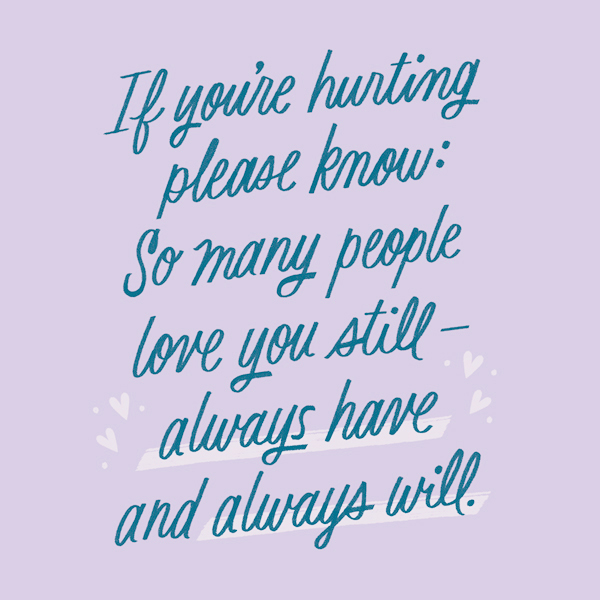How to Grieve Together When You Can’t Be Together

When someone has died, our first instinct is to rally around the family and friends closest to the deceased, offering comfort, bringing food and giving support of every kind. We depend on the formal structure a funeral or memorial service provides, finding solace in each other’s presence as we pay tribute, shed tears, share memories and say our goodbyes.
In short, we show up for each other.
Inspired? Create and share by tagging @HallmarkStores.
But how do we show up for a grieving friend when circumstances make it impossible to gather at a memorial service or wake, or to get together in person at all? There’s no easy or perfect answer to this, but basically, we make our peace with physical distance—at least for the time being—and find substitutes for our traditional rituals.
We’ve gathered tips and suggestions for hosting virtual gatherings as well as ways to reach out in meaningful ways on your own, below.

How to plan an online celebration of life
If you’re close to the immediate family, you might offer to coordinate an online celebration of life. Gathering folks digitally gives everyone a chance to share memories, cry and laugh together, and comfort each other. There are lots of ways to make it special, too. Here are a few to get you started:
Invite friends and family to gather online
Gathering everyone online is easier and less formal than hosting an in-person gathering.
- Contact a family member(s) and share your idea to host a virtual celebration of life. There are a variety of online services you can use: Zoom, Skype and Google Hangouts are popular options for groups.
- If they like the idea, ask to work with them to create an invitation list, and make sure to get email addresses or phone numbers for virtual guests. It’s hard to concentrate when you’re grieving, so add suggestions they might’ve forgotten, then send the list over to the family for final approval.
- Confirm a date and time convenient for the family, then invite the guests. You can contact them by phone, text, email or with a Facebook event invitation or create an online invitation. Later, you could follow up with a paper invitation for folks who like to keep scrapbooks and want a tactile memento of the celebration of life.
- If you design an invitation, you might send it to the family for approval on wording and design choice. It’s important that it reflects both their taste and their loved one’s taste.
- One more thing: If you choose a platform with recording capabilities, ask the family if it’s okay to capture the celebration of life. If so, make sure all guests know in advance the event will be recorded.
Helpful tips: Not everyone is comfortable with video chats, so be sure to include specific instructions on how to log in, mute devices and work the camera. Speaking of cameras: It’s a good idea to remind people that other people will be able to hear and see them. Emphasize the importance of wearing something that won’t embarrass them (at least from the waist up).
Give everyone easy ways to participate
Be sure to include specific plans for your online gathering in the invitation or follow-up communications with guests.
- Choose a place to gather in each of your respective homes. You ask guests to sit around their own dinner tables or outside on a patio or porch.
- Honor the deceased by sharing their favorite food. Suggest that everyone order or make the same meal, dessert or cocktail based on a menu or recipes you send in advance. Have a meal delivered to the immediate family before the call.
- Ask each guest to light a candle or have some flowers nearby.
- Suggest everyone wear something that reminds them of the person who’s died. A favorite color, piece of jewelry, t-shirt with their photo or favorite team or band, or a flower or ribbon representing a meaningful philanthropy are all little ways to pay tribute.
- Invite people to send a photo (or link to one) of themselves with the person you’ve lost. (We’ll suggest what to do with them in the next section.) Make it easy by giving them your email address or mobile phone number or asking them to post in a Facebook group or invitation.
- Offer options for giving by linking to a charity that was important to your loved one or offering to collect for a group donation. Include a brief description of the philanthropy’s mission
Plan a virtual “program” for the online event
Come up with a few simple, appropriate activities. You can include the program in the invitation so everyone knows what to expect:
- Slide show: Compile photos you’ve received, collected from the family, or gathered online into a slide show. You can “share” your screen in the virtual gathering so everyone can watch.
- Soundtrack: Compose an online playlist of your loved one’s favorite music to serve as a soundtrack for the slide show. Have guests submit songs, and when it’s done provide a link for everyone.
- Memories and stories: Request that guests bring a favorite memory or short story about the loved one to share. Make this optional for more reserved folks or those who may be too overwhelmed with grief—or let them email a message to be read by someone else.
- Toasts: Open and/or close with a heartfelt toast to the deceased, their family, or your group of friends. Ask someone to do the honor ahead of time so they can write a toast or compile other guests thoughts. (Here are some tips on making a toast.)
- Music: Provide lyrics for a favorite song and sing together. (Tap someone to lead. It will still be a little chaotic, and that’s OK.) Or dance to all of your loved one’s favorite songs—in your seat or all-out on your home dance floor.
Follow up after the memorial
- Contact the family a few days after the celebration of life to let them know you’re thinking of them. Say how honored you were to host their online wake and make sure they’ve received all of the links, photos and videos from the day.
- Reach out to guests to thank them for participating and offering their tributes and love. Make sure they’ve received any photo collages, toasts or speeches that were presented.

Ways to memorialize someone on your own
If you’d prefer to reach out to the family on your own, that’s just as beautiful. We hope these tips inspire you.
Start with your relationship
Give yourself some quite time to consider what the person you’ve lost meant to you: ways they influenced or inspired you, how they made you feel, what you loved about them. Think about unique aspects of your relationship—stories, memories, or sides of their personality not everyone got to see—you could share with their loved ones.
Think about how to share your feelings
Depending on what you’d like to express, there are a variety of ways to capture your thoughts:
- Cards and letters: Handwrite a letter to the family filled with stories and memories, lessons you learned, favorite quotes or habits, and acts you appreciated. Or find a card that perfectly sums up your feelings about their loved one and add a personal message. (Here are some ideas for things to write in a sympathy card.)
- Special skills: If you express yourself by telling stories, writing poems, drawing, crafting, cooking, gardening, or making music, use your talents to create a tribute. You can make a video or record a song on your phone, hand-letter a poem or create a collage, bake a special dessert or deliver a whole meal, or plant a tree or a whole garden.
- Photographs and mementos: If you have access to photos or videos, creative or work projects or other artifacts from your relationship with your lost loved one, make copies and share them with their immediate family. Details of the parts of their family member’s life they didn’t witness firsthand can be irreplaceable gifts.
- Commitments: Honor a legacy with a promise to do something—run a race in their memory, volunteer, carry on something they started, or improve your life or someone else’s.
Make a meaningful contribution
Donating to a charity with special meaning to your loved one or their family is a beautiful gesture in itself. Along acknowledging a donation in their name, some non-profits offer a tangible memorial as well. You might:
- Purchase a brick, plaque or another piece of a meaningful place, such as a school, park or church.
- Provide a scholarship to a camp or class.
- Figuratively “adopt” anything from a wild animal to a section of highway.
Check out our articles about supporting friends through their grief for ways to show you care in the weeks and months ahead:
- How to Help Someone Who is Grieving Immediately after a Loss
- Continuing Grief Support: How to Help Someone Who is Grieving over Time
- Grief Support on Anniversaries, Birthdays and Special Occasions
- Sympathy Gift Ideas for Offering Your Condolences and Support
For a caring person, these tips and ideas may not feel like quite enough for a time of grief. If you’re struggling with that gap between what’s needed and what’s possible, it might help to think of it this way: This is not what I wish I could do for my friend who’s hurting, but this is what I’m doing until I’m able to do more. Try to look at this time of distance as a chance to give ongoing comfort and support, until you can show up in person at last.
Shop Sympathy
See allYou may also like
See more-
Sympathy Sympathy messages: What to write in a sympathy card
Signing a sympathy card isn’t easy. We search for words. We wonder what would be comforting to hear. We worry about s...
-
Mother's Day When Mother’s Day is hard: Grieving on Mother's Day
Find a few ways to offer support and kindness when Mother's Day is hard.
-
Sympathy How to support a grieving friend
Advice on how to support a grieving friend, directly from people who went through it. Get ideas to show you care here.
-
Sympathy Sympathy gift ideas for offering your condolences and support
Many times, we don’t know what to say after a loss. It can be difficult to determine what will comfort a hurting frie...
-
Sympathy 75+ grief quotes to give you comfort and help you heal
Grieving the loss of a loved one feels different for everyone, and there’s no telling what will bring comfort on a ha...
-
Valentine's Day Ways to find comfort and hope when you’re grieving on Valentine’s Day (or support someone who is)
Grief is always hard, but especially on Valentine’s Day. From social media to stores to kids’ classrooms, it can feel...
-
Valentine's Day How to survive Valentine’s Day after a divorce or breakup
We know that ending a relationship can be extremely heartbreaking. It’s a very significant loss, and when Valentine’s...
-
Mother's Day Mother's Day without Mom: Remembering lost loved ones with new traditions
This Mother’s Day will be my third without my mom. She died just before Thanksgiving and Christmas in 2020, which mad...
-
Lifestyle How to Write an Obituary: What to Say About the Life of a Loved One
Summarizing a loved one’s life can feel like an impossible task, especially when you’re grieving. It’s even more chal...
-
Card Ideas What to Say When Someone Loses a Pet
My first cat died when I was 8 years old. His name was Barnabus—after the soap opera vampire—and he was a handsome bl...
-
Friends How to survive a friendship breakup
There are a few things that I dreamed of having more than anything as a kid—like a golden retriever, my own room, mer...
-
Christmas A Christmas tribute: meaningful ways to weave memories of lost loved ones into new holiday traditions
For many of us, Christmas is the time of year when we miss our lost loved ones the most. Finding ways to memoriali...
-
Sympathy Grief and the holidays: Supporting friends through difficult days
Many of our favorite holiday memories include family members and our closest friends. So it’s no surprise that people...
-
Baby What to Say When a Friend Loses a Baby: Messages of Love and Support
Losing a baby, no matter how it happens—or how early in the pregnancy—is devastating. It’s a time of sadness when ...
-
Sympathy Grief support: How to help someone who is grieving immediately after a loss
When a friend suffers the loss of a loved one, their whole life changes. And we wonder: What can we do to help som...
-
Sympathy Continuing Grief Support: How to Help Someone Who is Grieving over Time
Grief doesn’t follow a schedule. There’s no deadline for the feelings of sadness, anger and loneliness to subside ...
-
Sympathy Grief support on anniversaries, birthdays and special occasions
When you’re supporting a friend through their grief, look to the calendar for cues about when they might need extr...
-
Sympathy Hospice Messages: What to Write to Someone Who is Dying
The end of a person’s life is an important time for friends and family members to reach out with words of caring, ...
-
Sympathy Grief and loss: how to comfort the grieving
The sympathy cards have been safely tucked away. The flowers have been careful...




















